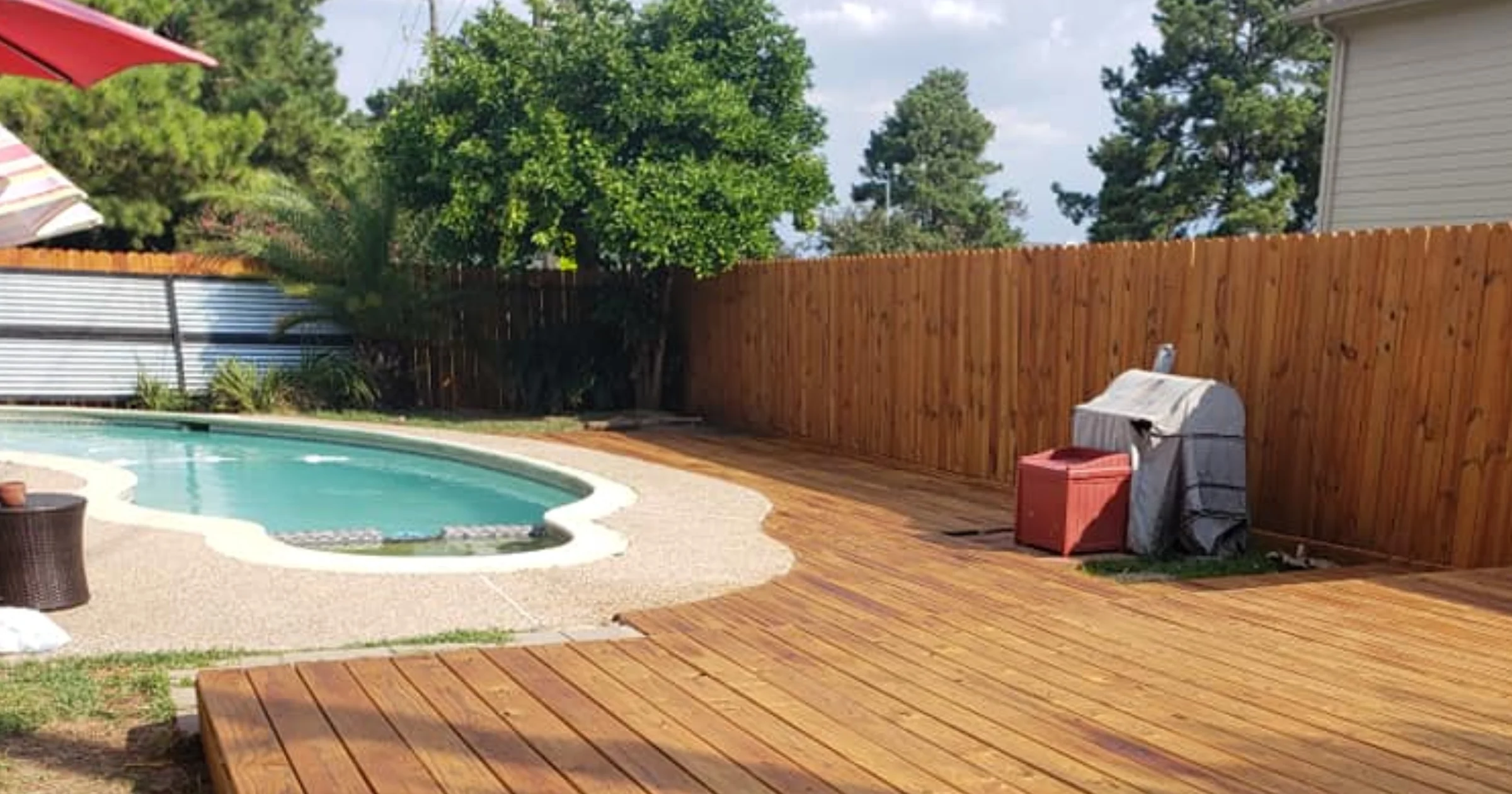
Protecting your fence, deck, or pergola represents one of the smartest investments Houston-area property owners can make. According to the Texas A&M Forest Service, untreated wood surfaces in Houston’s subtropical climate begin showing deterioration within 6-12 months of installation.
Fence and deck staining mistakes can cost homeowners thousands in premature wood replacement and property value reduction. Understanding proper timing, preparation, and product selection ensures optimal protection against Houston’s demanding weather conditions while avoiding costly application errors.
At Ninja Fence Staining, we help homeowners throughout Cypress, Spring, Tomball, Katy, and The Woodlands avoid these critical fence and deck staining mistakes that compromise wood protection and waste investment dollars. Our complete staining services address these common issues while ensuring optimal protection for Houston properties.
Before starting any project, homeowners should understand how to get free staining estimates to ensure proper planning and professional guidance.
Mistake #1: Incorrect Application Timing
Houston homeowners frequently receive conflicting advice about optimal fence and deck staining timing, leading to application errors that compromise wood protection effectiveness.
The New Wood Dilemma
After installing new fencing or decking, property owners encounter varying recommendations from different sources. Some contractors suggest immediate staining, while others recommend waiting months or even years before application.
Modern pressure-treated lumber arrives with elevated moisture content that prevents proper stain penetration. However, delaying application too long allows UV damage, surface checking, and moisture intrusion that compromise wood integrity.
Houston Climate Timing Considerations
Field experience across Houston-area neighborhoods reveals that new wood surfaces typically reach optimal moisture content levels between 2-6 weeks after installation.
During this period, wood moisture levels drop to approximately 13%, creating ideal conditions for maximum stain penetration.
Houston’s intense UV radiation and high humidity accelerate both drying and surface degradation processes. Fence and deck staining applications must occur within this narrow window to achieve optimal penetration before surface hardening or checking occurs.
DIY Testing Method: Sprinkle water droplets on your fence. If water beads up, the wood is too wet for staining. If water soaks in within 5-10 minutes, the wood is ready for stain application.
Addressing Weathered Wood Surfaces
Previously untreated wood surfaces that have experienced weathering remain suitable for fence and deck staining applications with proper preparation.
Gray, weathered surfaces require comprehensive cleaning and preparation before stain application to ensure adequate penetration and adhesion.
Professional assessment helps determine whether weathered surfaces require restoration cleaning or more intensive preparation procedures.
Mistake #2: Inadequate Surface Preparation
Houston’s humid subtropical climate creates unique challenges for wood surface preparation that many homeowners underestimate or ignore entirely. Insufficient preparation represents the primary cause of premature fence and deck staining failure.
Climate-Specific Preparation Requirements
Project inspections throughout Houston neighborhoods reveal that 85% of untreated wood surfaces develop mold, algae, or mildew contamination within the first year of installation.
These biological contaminants interfere with stain penetration and create adhesion problems that cause premature coating failure.
Houston’s high humidity levels, particularly in areas near Buffalo Bayou, White Oak Bayou, and other waterways, accelerate biological contamination development.
Essential Preparation Steps
Step 1: Clean Contamination Use professional-grade wood cleaning products specifically formulated for biological contamination. Standard household cleaners lack the effectiveness necessary for thorough contamination removal.
Step 2: Low-Pressure Washing Remove cleaning residues and loosened contamination without damaging wood fibers. High-pressure washing can damage wood surfaces and drive contamination deeper into wood pores.
Step 3: Ground-Level Preparation Remove grass, mulch, and soil accumulation from fence base areas to prevent splash-back contamination during application.
Step 4: Proper Masking Protect air conditioning units, concrete surfaces, and adjacent structures from overspray damage.
Step 5: Complete Drying Houston’s humidity can extend drying periods, making timing coordination essential for application success. Understanding how to prepare for fence staining day ensures optimal surface conditions.
DIY Preparation Checklist:
- Test multiple fence sections for contamination
- Purchase appropriate cleaning products from professional suppliers
- Plan 2-3 days for complete cleaning and drying process
- Check weather forecast for dry conditions
Mistake #3: Inappropriate Product Selection
Product selection errors represent the most costly fence and deck staining mistakes Houston homeowners make. Choosing inappropriate formulations for local climate conditions results in premature failure and expensive reapplication requirements.
Water-Based vs Oil-Based Performance
Water-based stain formulations offer specific advantages for certain applications but demonstrate limitations in Houston’s climate conditions.
These products work effectively when covering previously painted surfaces or hiding significant wood defects with solid-color formulations.
Semi-transparent water-based stains frequently produce streaky, uneven coverage on Houston wood surfaces due to rapid moisture evaporation and uneven penetration characteristics.
Oil-based penetrating stains represent the optimal choice for Houston fence and deck staining applications. These formulations provide superior wood penetration, weather resistance, and longevity compared to surface-coating alternatives.
Houston Climate Performance Data
Local performance data from neighborhoods including Willowbrook, Cypress Creek Lakes, and Lakewood demonstrates superior longevity from oil-based stain applications.
These products typically provide 2-3 years of reliable protection before reapplication becomes necessary.
Oil-based formulations allow natural wood movement and moisture vapor transmission, preventing moisture entrapment that leads to rot and structural damage.
Deep wood penetration provides protection against moisture intrusion, UV degradation, and biological contamination.
DIY Product Selection Guide:
- Choose oil-based stains for Houston climate conditions
- Verify VOC compliance with Texas environmental regulations
- Select semi-transparent formulations for natural wood appearance
- Purchase from professional-grade suppliers for quality assurance
Specialized Houston Applications
Specific Houston neighborhoods maintain HOA requirements that influence product selection decisions.
Understanding local regulations ensures compliance while optimizing performance characteristics.
Deck applications require specialized consideration due to horizontal surface exposure and potential foot traffic. Fence and deck staining products must address different performance requirements for vertical fence surfaces versus horizontal deck applications.
Making Informed Decisions
Successful fence and deck staining requires understanding Houston’s unique climate challenges and avoiding common application mistakes.
Proper timing, thorough preparation, and appropriate product selection ensure optimal protection and longevity regardless of whether homeowners choose DIY or professional application.
For Houston homeowners seeking professional expertise, fence staining services provide comprehensive solutions designed specifically for local climate conditions.
Contact Ninja Fence Staining at (832) 258-6164 for expert guidance on avoiding costly staining mistakes while achieving optimal wood protection for your Houston property throughout Cypress, Spring, Tomball, Katy, and The Woodlands.

